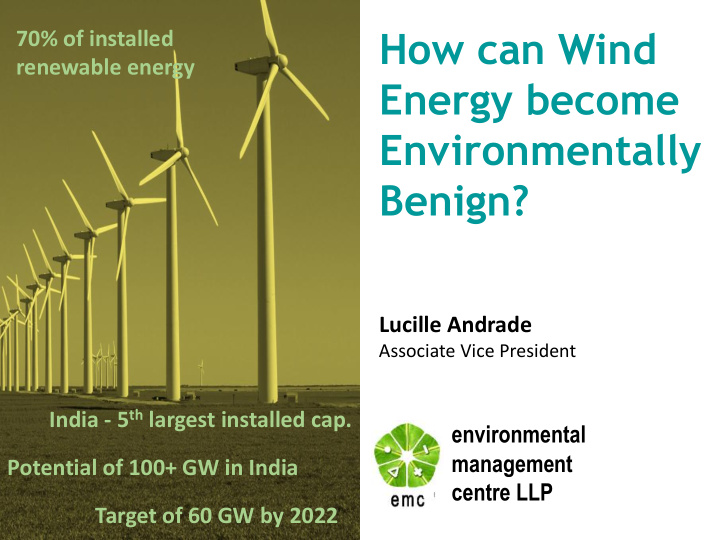



How can Wind 70% of installed renewable energy Energy become Environmentally Benign? Lucille Andrade Associate Vice President India - 5 th largest installed cap. environmental management Potential of 100+ GW in India centre LLP Target of 60 GW by 2022
Landscape/ Viewscape impacts Noise impact Shadow Flicker Biodiversity impacts Effect
Wind Energy projects do not require Environmental Clearance by Indian law. International Financing Institutions investing in wind energy require Environmental Impact Assessment studies to be conducted. Classical EIA in India carried out after finalizing locations or in final stages. Impacts are linked to location of turbine ESIA for wind farms should be conducted at research stage. Location finalized after a year long study WTGs once installed cannot be moved EMC developed a phased approach for E&S Impact Assessment of Wind Energy projects Assessment based on World Bank Groups EHS Guidelines for Wind Energy
EMC Three-stage Approach for E&S Impact Assessment of Wind Energy Projects Early Research Screening of location (presence of Stage priority set of E&S sensitive receptors) Desk-based Rapid Impact Finalization of Assessment (mapping of E&S sensitive Location by receptors; noise & shadow flicker effect Research Team modelling) Bird and Bat Diversity Assessment (field surveys in winter for migratory birds and pre/post monsoon for bat roosts)
1- Screening Presence/ Absence of critical E&S sensitive Receptors • Archeological sites • National Parks/Wildlife Sanctuaries • Eco-sensitive zone • Natural Hazards (earthquake, cyclone, floods) • Important Bird Areas • Tribal/ Scheduled areas • Airports
2- Rapid E&S Impact Assessment (desk-based) 10 km buffer around the boundary of wind farm area • Secondary Data Collection Analysis of • Creation of data layers for sensitive receptors in GIS ( Image Baseline Status processing, digitization, Validation) • Socio-Economic Analysis • Analysis of Cropping Pattern • Meteorological Analysis • Impact Defining safety buffers from E&S sensitive receptors Assessment • Scenario generation for locating WTGs within wind farm boundary • Noise and Shadow Flicker Effect Modelling for above scenarios • Identification of impacted receptors based on modelling results for the above scenarios Management Recommendations for locating WTGs with least disturbance Plan to E&S sensitive receptors
Impact Assessment- Noise Using ISO 9613-2 General Model in WindPro 3.0 software
Impact Assessment- Shadow Flicker Shadow Flicker module in WindPro 3.0 & SRTM data(30m resolution)
Literature Review 3- Bird & Bat Diversity Assessment (on-site) Primary Survey Winter Pre-Monsoon Survey Survey Bilateral Meetings & Bird Counts Impact Assessment Bird Sensitivity Map (IUCN Status + Migratory Species + Shannon Diversity + Taxonomic Order) Critical Areas Map (Bird Sensitivity Map + Bat roost buffer) Recommendations on Siting WTGs
Bird & Bat Critical Areas Map
Conclusion Conduct of Environmental and Social Impact Assessment for wind farms at research stage is important for tapping true potential of wind energy in an environmental friendly manner.
Environmental Management Centre LLP 504/505, 5th Floor, Balarama Building, Bandra Kurla Complex, Near MMRDA Office, Bandra (East), Mumbai 400051 Maharashtra, INDIA P : +91-22-62215944 / 5946 W : www.emcentre.com E: Lucille.andrade@emcentre.com/
Recommend
More recommend